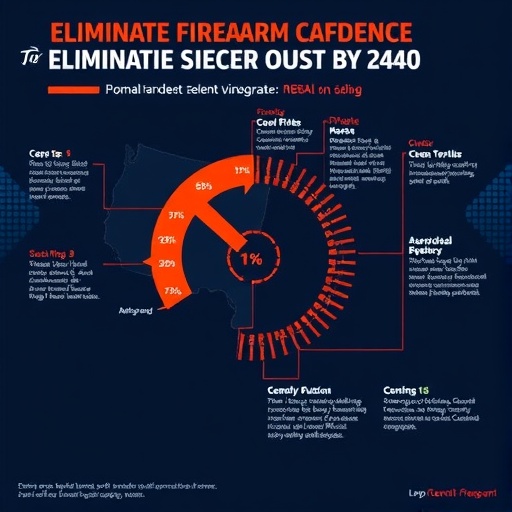A groundbreaking report published in the Journal of the American Medical Association (JAMA) has laid out an ambitious roadmap to drastically diminish firearm violence and its associated harms across the United States by the year 2040. This comprehensive blueprint emerges from a two-day summit held in March, where a distinguished panel of 60 experts from various disciplines, including public health, criminology, sociology, social work, and public policy, converged to chart a multifaceted approach to this persistent societal challenge. The report deftly balances technological innovation with social reform, emphasizing the complex nature of firearm violence and the imperative of addressing its root causes.
Firearm violence in the United States remains a tragically pervasive public health crisis. Since 2000, over 800,000 Americans have lost their lives to firearms, with more than two million people sustaining injuries. The data presented in the report depicts a sobering reality: firearm homicides reached a peak of 21,383 deaths in 2021 but have slightly decreased to an estimated 16,725 in 2024. Even more alarming is the steady rise in firearm suicides, which constitute two-thirds of all firearm-related deaths, with numbers climbing to over 27,000 in 2023. Such statistics underscore the urgency of innovative and sustainable strategies to stem this tide.
The summit coalesced around a nuanced understanding that reducing firearm violence entails far more than legislative reforms alone. While the U.S. Supreme Court decisions have constrained certain gun control measures, the report underscores that numerous statutes—such as mandatory background checks, secure firearm storage requirements, and protocols for the surrendering of weapons by high-risk individuals—remain constitutionally sound. These existing legal frameworks provide a foundation upon which further preventative measures can be built, circumventing some of the legal hurdles that often stall policy progress.
One of the keystone recommendations centers on harnessing the transformative potential of artificial intelligence (AI) and emerging technologies to detect concealed weapons and identify high-risk scenarios. The report highlights that AI could revolutionize law enforcement and community intervention programs by analyzing vast datasets to pinpoint individuals and locales with elevated risks of firearm violence. However, this technological leap comes with intrinsic dilemmas: safeguarding privacy, preserving civil liberties, and preventing discriminatory profiling. Ethical deployment of AI must proceed with symbiotic legal and societal safeguards in place, a caveat emphasized by the report’s authors.
Complementing technology-driven solutions is a pronounced focus on societal programs designed to tackle the underpinnings of violence. Community violence-intervention initiatives emerge as vital components in this strategy, bridging law enforcement with social services to extend housing, financial aid, employment training, and therapeutic resources to individuals at elevated risk. These multidisciplinary programs recognize that the path to safety is not paved by enforcement alone but through holistic support systems that empower communities and individuals.
The report introduces the concept of “primordial prevention,” an innovative paradigm that seeks to alter the foundational social conditions which incubate violence. By championing policies aimed at housing stability, economic opportunity, environmental enhancements, and equitable governance, the report envisions the dismantling of entrenched inequities wrought by decades of segregation, neglect, and systematic disinvestment. This strategy aims to restore community trust, redistribute societal power, and reengineer environments to foster long-term peace and health.
Psychological harm caused by firearm violence receives significant attention in the report, which expands the definition of harm beyond physical injury and death. It recognizes the pervasive mental health toll on survivors, witnesses, and entire communities living under the persistent threat of gun violence. This broadened perspective necessitates integrated trauma-informed care and community resilience initiatives as essential facets of comprehensive violence reduction efforts.
Despite the gravity of firearm-related harm, the report’s authors maintain a pragmatic lens, acknowledging the constitutional realities of gun ownership in America—home to approximately 400 million privately held firearms. This recognition informs their call for pragmatic innovation, rather than blanket prohibition, distinguishing their proposals from polarizing rhetoric. They advocate a harmonized approach that respects the Second Amendment while prioritizing public safety through shared responsibility and collective action.
The synthesis of diverse disciplinary expertise in the report lends it an authoritative voice in the public discourse on firearm violence. Contributions from epidemiologists, pediatricians, sociologists, criminologists, and policymakers enrich the analysis, underscoring the multidimensional nature of both the problem and its potential solutions. This collaborative model exemplifies the necessity of transdisciplinary engagement for tackling complex societal issues.
The report also addresses the critical role of public health surveillance and data analytics in creating targeted interventions. Robust data infrastructures can inform resource allocation, evaluate program efficacy, and enhance predictive capabilities to prevent outbreaks of violence. This empirical approach champions evidence-based policymaking and continuous learning as cornerstones of sustainable violence reduction.
Importantly, the report calls for a cultural shift in how firearm violence is perceived and addressed nationally. It urges stakeholders—from government agencies to community leaders and citizens—to adopt an integrated framework that synthesizes enforcement, prevention, social equity, and mental health to forge a safer future. The vision set forth is ambitious but grounded in scientific rigor and social pragmatism.
In sum, this JAMA report represents a timely and transformative roadmap toward a safer America by 2040. By pioneering a synthesis of cutting-edge technology, community-centered programs, and structural reforms targeting social determinants of violence, it offers a comprehensive framework for policymakers, practitioners, and the public. The challenge remains formidable, but the path illuminated is one of hope, innovation, and shared commitment to ending the cycle of firearm violence.
Subject of Research: People
Article Title: Toward a Safer World by 2040: The JAMA Summit Report on Reducing Firearm Violence and Harms
News Publication Date: 3-Nov-2025
Web References: 10.1001/jama.2025.18076




